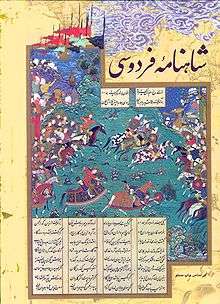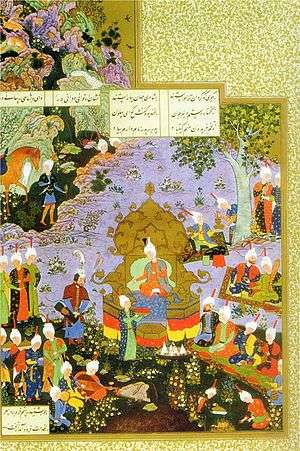Hushang
Hushang or Hōshang (in Persian: هوشنگ), older Persian Hōšang, was the second Shāh to rule the world according to Ferdowsi's Shāhnāmeh. Hushang is based upon the legendary figure Haošyaŋha in the ancient Zoroastrian scripture of the Avesta.
Hushang is also called Pishdād (پیشداد), older Pēšdād, corresponding to Avestan Paraδāta.
Etymology
Haošyaŋha is the Avestan development of Proto-Iranian *Haušyahah, containing the prefix *Hau-, a derived form of *Hu-, "good, well", and an uncertain root šyah-, possibly to be interpreted as "selecting" or "deciding". ُThe name might then be interpreted "of the good choice".
Haošyaŋha in Zoroastrian literature
Haošyaŋha's original status is uncertain. He may have begun as a demon-defeating hero, or may have been a rival for the title of first man (or first king) with Gayōmart. One trace that may remain of that status is the labelling of the entire early line of kings as "Pishdādi", after Hushang's name Pishdād.
The Reign of Hushang
The just and prudent Hushang was now master of the world, and he set the crown on his head and ruled in his grandfather's place. He reigned for forty years, and his mind was filled with wisdom, his heart with justice. Sitting on the royal throne, he said, “From this throne I rule over the seven climes, and everywhere my commands are obeyed." Mindful of God's will, he set about establishing justice. he helped the world floursih, and filled the face of the earth with his just rule.
Hushang in the Shāhnāma
.png)
In the epic poem of the Shāhnāmeh, Hushang was the son of Siyāmak and grandson of Keyumars. He led the army against the son of Ahriman that avenged the death of Siyāmak. After the death of Keyumars, Hushang became king of the human race. During Hushang's reign, many new discoveries were made for the comfort of humanity. Hushang discovered iron and the principles of iron-working; the methods of agriculture and irrigation; he learned how to domesticate certain beasts as livestock and for use as draught animals; how to make clothing from the furs of other beasts; and he discovered how to make fire from flint. This happened when Hushang hurled a flint rock to kill a venomous black serpent. Missing the serpent, the rock struck another flint to produce fiery sparks. Hushang learned how to make fire this way, and taught his people; in honor of the discovery, they established the Sadeh festival. After a reign of forty years, he left the kingdom to his son Tahmuras.[1][2][3][4]
References
- ↑ Goodrich, S. C. (1864). A History of All Nations (Digitized Nov 23, 2005 ed.). Original from the University of Michigan.
- ↑ Rosenberg, Donna (1997). "page 116-118". Folklore, Myths, and Legends: A World Perspective. McGraw-Hill Professional. p. 536. ISBN 0-8442-5780-X.
- ↑ Reed, Elizabeth Armstrong (1893). "XI". Persian Literature: Ancient and Modern. Original from Harvard University (Digitized Feb 5, 2007 ed.). S. C. Griggs and company. p. 419.
- ↑ Khayyam, Omar; Edward FitzGerald (1900). "The Sha Nameh, pages 50-67". In Translated by Herman Bicknell, James Ross. Persian Literature... Original from the University of Michigan. 1. Ḥāfiẓ, Saʻdī (revised ed.). page 50-: The Colonial press.
External links
- A king's book of kings: the Shah-nameh of Shah Tahmasp, an exhibition catalog from The Metropolitan Museum of Art (fully available online as PDF), which contains material on Hushang
- Shahbazi, A. Shapur. "HŌŠANG". Encyclopædia Iranica. Retrieved 27 February 2016.
| Preceded by Keyumars |
Legendary Kings of the Shahnameh 30-70 (after Keyumars) |
Succeeded by Tahmuras |


.png)